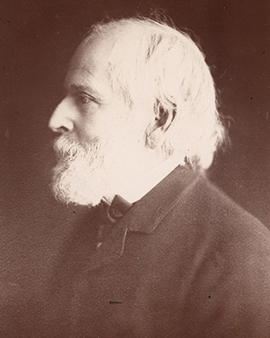The America of the 19th century was dominated by three major themes. The discovery of the country, the exploration and settlement of the landscape in the West. There was a spirit of optimism. The urbanization that had already advanced on the east coast was to be carried over to the west. By the beginning of the century an artistic scene had established itself in the cities on the west coast. Especially in New York and Philadelphia a group of artists had made it their task to capture the landscapes of the East and to create a symbiosis of man and nature. After initial attempts in arts and crafts, the Philadelphia-born painter William Trost Richards found an artistic home with the American landscape painters.
The preferred motifs Richards found in his personal environment. At the beginning of his creative period he was drawn to the banks of the Hudson and the Catskills Mountains. Later, the painter preferred the coastal landscape, the waves of the Atlantic and the wild and romantic rocks of Rhode Island. In the span of his artistic development, Richards made regular trips to Europe. The play of light of the Romantic period influenced the artist and left its mark on the works of the airy sea scenes. Richards collected maritime inspirations on study trips through Northern Europe. England in particular impressed the painter so much that he spent the rest of his life in the United Kingdom.
William Trost Richards was born into a time of change and has developed into an artist who is difficult to define as a typical representative of an epoch. The works fit into the series of the Hudson River School and show the complete span between art oriented towards realism and the influences of romanticism. While the art scene of the American West Coast has tried to form an individual profile, immigrant Europeans have constantly brought influences to art that have led to controversy and upheaval. Richard's work is differentiated and shows, especially in his last years of work, the influences of the European Impressionists. The initial realism gives way to an atmospheric ideal landscape.
×





.jpg)
.jpg)
.jpg)
.jpg)
.jpg)
.jpg)
.jpg)
.jpg)
.jpg)
.jpg)
.jpg)
.jpg)
 - (MeisterDrucke-639236).jpg)
 - (MeisterDrucke-639236).jpg)
.jpg)
.jpg)
 - (MeisterDrucke-643644).jpg)
 - (MeisterDrucke-643644).jpg)
.jpg)
.jpg)
.jpg)
.jpg)
.jpg)
.jpg)
.jpg)
.jpg)
.jpg)
.jpg)
.jpg)
.jpg)
.jpg)
.jpg)
.jpg)
.jpg)
.jpg)
.jpg)
.jpg)
.jpg)
.jpg)
.jpg)
.jpg)
.jpg)
 - (MeisterDrucke-639953).jpg)
 - (MeisterDrucke-639953).jpg)
.jpg)
.jpg)
_-_(MeisterDrucke-1347787).jpg)
_-_(MeisterDrucke-1347787).jpg)
.jpg)
.jpg)
.jpg)
.jpg)
.jpg)
.jpg)
 - (MeisterDrucke-598067).jpg)
 - (MeisterDrucke-598067).jpg)
.jpg)
.jpg)
.jpg)
.jpg)
.jpg)
.jpg)
.jpg)
.jpg)
.jpg)
.jpg)
.jpg)
.jpg)
.jpg)
.jpg)
.jpg)
.jpg)
.jpg)
.jpg)
 - (MeisterDrucke-643642).jpg)
 - (MeisterDrucke-643642).jpg)
.jpg)
.jpg)
.jpg)
.jpg)
.jpg)
.jpg)
.jpg)
.jpg)
.jpg)
.jpg)
.jpg)
.jpg)
.jpg)
.jpg)
.jpg)
.jpg)
.jpg)
.jpg)
.jpg)
.jpg)
 - (MeisterDrucke-635979).jpg)
 - (MeisterDrucke-635979).jpg)
.jpg)
.jpg)
.jpg)
.jpg)
.jpg)
.jpg)
.jpg)
.jpg)
.jpg)
.jpg)
 - (MeisterDrucke-143008).jpg)
 - (MeisterDrucke-143008).jpg)
.jpg)
.jpg)
 - (MeisterDrucke-639243).jpg)
 - (MeisterDrucke-639243).jpg)
.jpg)
.jpg)
.jpg)
.jpg)
.jpg)
.jpg)
.jpg)
.jpg)
.jpg)
.jpg)
.jpg)
.jpg)
.jpg)
.jpg)
.jpg)
.jpg)
.jpg)
.jpg)
.jpg)
.jpg)
.jpg)
.jpg)
.jpg)
.jpg)
.jpg)
.jpg)
.jpg)
.jpg)
.jpg)
.jpg)
.jpg)
.jpg)
.jpg)
.jpg)
.jpg)
.jpg)
.jpg)
.jpg)
.jpg)
.jpg)
.jpg)
.jpg)
.jpg)
.jpg)
.jpg)
.jpg)
_-_(MeisterDrucke-658708).jpg)
_-_(MeisterDrucke-658708).jpg)
.jpg)
.jpg)
 - (MeisterDrucke-639260).jpg)
 - (MeisterDrucke-639260).jpg)
.jpg)
.jpg)
.jpg)
.jpg)
_-_(MeisterDrucke-1490263).jpg)
_-_(MeisterDrucke-1490263).jpg)
.jpg)
.jpg)
.jpg)
.jpg)
.jpg)
.jpg)
.jpg)
.jpg)
.jpg)
.jpg)
.jpg)
.jpg)
.jpg)
.jpg)
.jpg)
.jpg)
 - (MeisterDrucke-639951).jpg)
 - (MeisterDrucke-639951).jpg)
.jpg)
.jpg)
 - (MeisterDrucke-639956).jpg)
 - (MeisterDrucke-639956).jpg)
.jpg)
.jpg)
.jpg)
.jpg)
.jpg)
.jpg)






